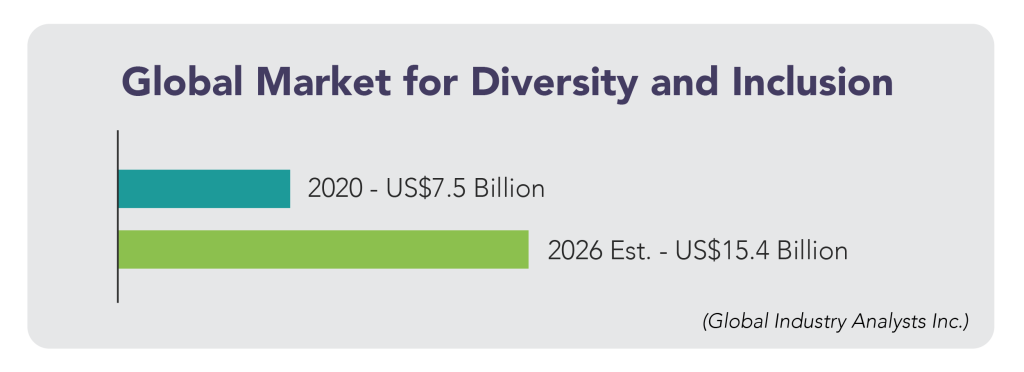
Think about the diversity, equity, inclusion and belonging (DEIB) efforts in your organisation. How familiar are you with these initiatives? Do you know what sort of impact they are making?
If you’re part of the team leading DEIB programmes, you are likely very aware of the work that has been implemented. However, in many companies, this familiarity drops off quickly among the workforce.
A survey in the Harvard Business Review found that 97% of Human Resources professionals in large companies say their organisations have made changes to improve DEIB, yet 34% of surveyed employees shared that they do not know whether their companies are making inclusion-related adjustments.
The disconnect seems surprising given the increased investment companies have made in DEIB.

As studies have revealed diversity’s positive impact on multiple aspects of business from innovation to performance to profitability, the focus on inclusion has been heightened. Additionally, more organisations are connecting with diverse populations as they hire employees and work with customers from all across the world.
When individuals are exposed to other viewpoints, cultures and ways of operating, it follows that leaders would want to understand these distinct perspectives, so they may identify the best ways to engage staff and clients.
To find common ground, it’s ideal for everyone in the workplace to adopt a welcoming mindset where differences are met with curiosity rather than judgement, and individuals feel safe enough to be authentic with one another. Still, it seems that many businesses struggle to truly integrate diversity and belonging into their corporate climate.
Common Obstacles to an Inclusive Workplace
DEIB efforts face their fair share of challenges. Change management initiatives in general are only successful about 30% of the time. Whenever change is introduced, the process can be challenging.
The obstacles typically include a lack of buy-in from leaders or staff, ineffective measures and metrics, poor communication about the effort or an incomplete strategy. Within the context of DEIB, each of these barriers can impact implementation.
I’ve also found that executives often approach DEIB work through the lens of a campaign instead of weaving authenticity and belonging into the DNA of their companies.
Inclusion: Initiative or Value?
It’s common to focus on targeted tactics that aim to achieve specific goals related to equity or belonging, such as a quota for representation or metrics concerning training attendance. Setting objectives is certainly important as it allows stakeholders to understand where the company is heading, and it can help leaders establish a roadmap for success.
However, when DEIB is solely approached from a tactical perspective, it rarely becomes absorbed as part of the organisation’s ethos. To shift how individuals behave and interact, the changes must be woven into workplace culture.
If employees, at all levels, do not adopt day-to-day practices and attitudes that demonstrate that they welcome differences and want to create an environment where people can be their authentic, multidimensional selves, it can have a negative impact on the overall success of DEIB intentions. When psychological safety is fully embraced, the workforce will be better equipped to create a thriving atmosphere for all.
7 Indicators of Inclusive Environments
Companies that truly embrace equity and belonging often share common characteristics.
- Multiple teams, not just one leader or the HR department, are involved in and accountable to the success of DEIB efforts.
- Participation in inclusion-related training is high across all levels of the organisation.
- Companies actively solicit employee voice and respond to the concerns and needs raised.
- Employees in a multitude of demographics are comfortable speaking up and sharing their experiences.
- Leaders and managers are open to feedback and remain humble when receiving constructive inputs.
- Authenticity and empathy are valued across the business.
- Diversity is appreciated through multiple, intersectional lenses such as gender, race, orientation, abilities, thinking and behavioural types, education, age and socioeconomic status.
Moving to an Inclusive State
Culture change takes time, so I recognise that adopting an integrated approach will not happen immediately in any company. For executives who are motivated to move beyond a “campaign-mentality,” start by examining the reasons why DEIB is integral to company practices.
While these considerations can include the financial impacts, it’s important to be mindful of the holistic reasons behind this mindset shift by asking:
- How does diversity and belonging connect to the core values of the business?
- In what ways does it influence the people employed by the organisation as well as its customers and community?
- What does belonging do for the future state of the company?
Involving employees in these conversations can help to establish a shared vision and create buy-in for a more complete approach to work. With greater clarity into the connection between DEIB and the practices of the business, leaders can begin translating greater understanding into tangible behaviours and expectations.
To begin making those adjustments, I invite you to be on the lookout for an upcoming blog post, where I share a little more about how to build psychological safety to empower all individuals to thrive in the workplace.
Discover how Emergenetics can empower staff to embrace the value of different perspectives.
Explore our website or fill out the form below to speak with one of our team members today!
 Print This Post
Print This Post

